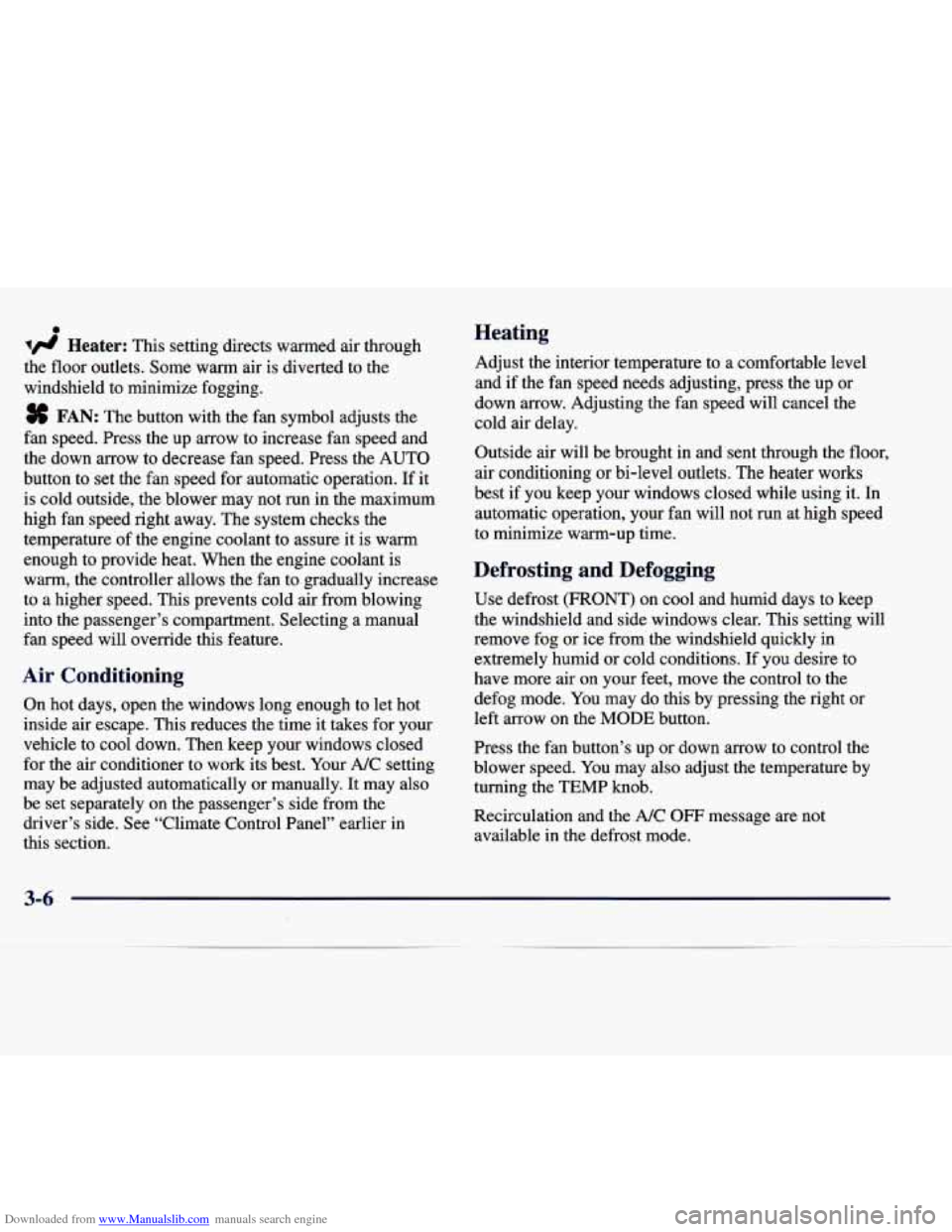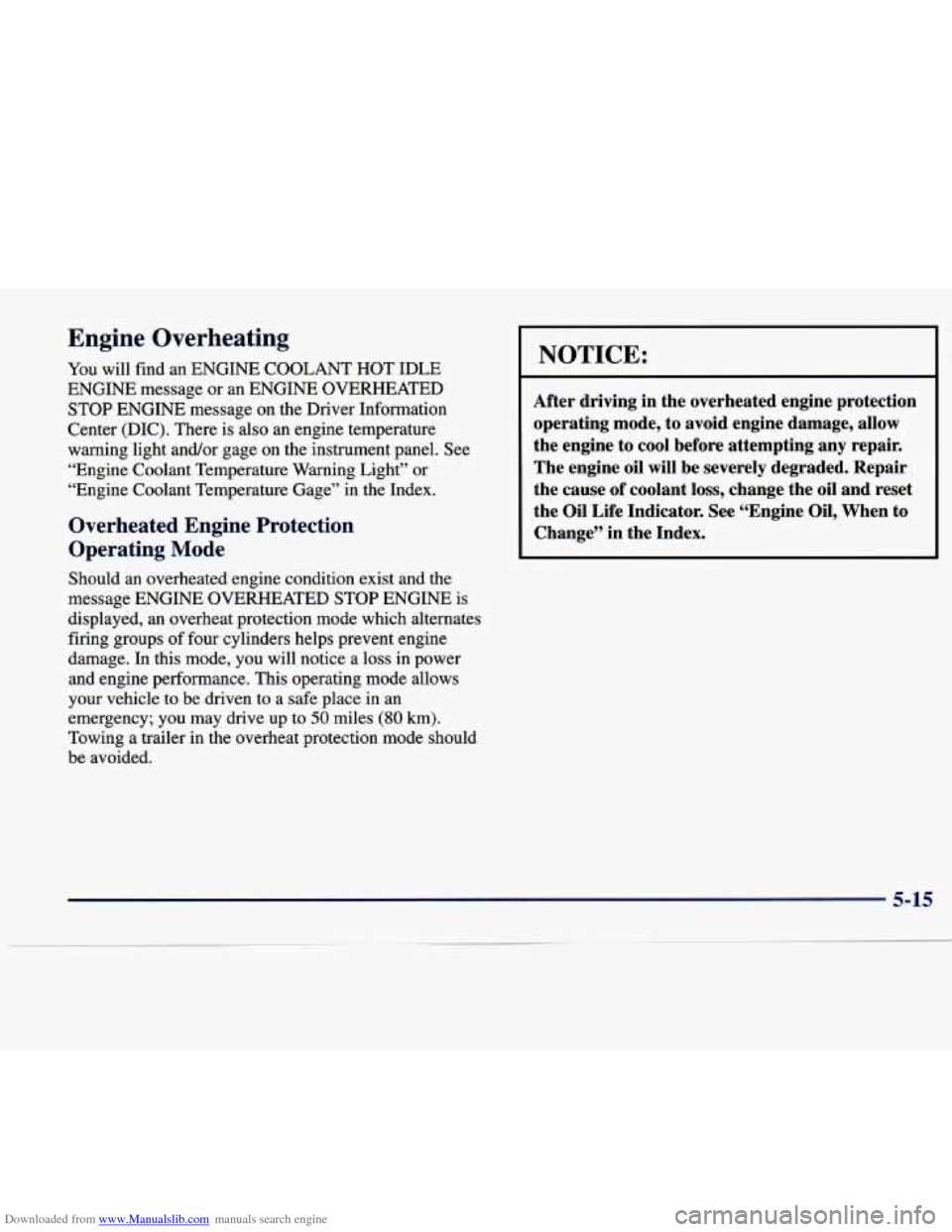Page 157 of 378

Downloaded from www.Manualslib.com manuals search engine 0
I# Heater: This setting directs warmed air through
the floor outlets. Some warm air is diverted to the
windshield to minimize fogging.
8 FAN: The button with the fan symbol adjusts the
fan speed. Press the up arrow to increase fan speed and
the down arrow to decrease fan speed. Press the AUTO
button to set the fan speed for automatic operation.
If it
is cold outside, the blower may not run in the maximum
high fan speed right away. The system checks the
temperature of the engine coolant to assure it is warm
enough to provide heat. When the engine coolant is
warm, the controller allows the fan to gradually increase
to a higher speed. This prevents cold air from blowing
into the passenger’s compartment. Selecting a manual
fan speed will override this feature.
Air Conditioning
On hot days, open the windows long enough to let hot
inside air escape. This reduces the time it takes for your
vehicle to cool down. Then keep your windows closed
for the air conditioner to work its best. Your A/C setting
may be adjusted automatically or manually.
It may also
be set separately on the passenger’s side from the
driver’s side. See “Climate Control Panel” earlier in
this section.
Heating
Adjust the interior temperature to a comfortable level
and if the fan speed needs adjusting, press the up or
down arrow. Adjusting the fan speed will cancel the
cold air delay.
Outside air will be brought in and sent through the floor,
air conditioning or bi-level outlets. The heater works
best if you keep your windows closed while using it. In
automatic operation, your fan will not run at high speed
to minimize warm-up time.
Defrosting and Defogging
Use defrost (FRONT) on cool and humid days to keep
the windshield and side windows clear. This setting will
remove fog or ice from the windshield quickly in extremely humid or cold conditions. If you desire to
have more air on your feet, move the control to the
defog mode. You may do this by pressing the right or
left arrow on the
MODE button.
Press the fan button’s up or down arrow to control the
blower speed. You may
also adjust the temperature by
turning the TEMP
knob.
Recirculation and the A/C OFF message are not
available in the defrost mode.
3-6
.
Page 252 of 378

Downloaded from www.Manualslib.com manuals search engine Engine Overheating
You will find an ENGINE COOLANT HOT IDLE
ENGINE message or an ENGINE OVERHEATED
STOP ENGINE message on the Driver Information
Center (DIC). There is also an engine temperature
warning light and/or gage on the instrument panel. See
“Engine Coolant Temperature Warning Light” or
“Engine Coolant Temperature Gage” in the Index.
Overheated Engine Protection
Operating Mode
NOTICE:
After driving in the overheated engine protection
operating mode, to avoid engine damage, allow
the engine to cool before attempting any repair.
The engine oil will be severely degraded. Repair
the cause
of coolant loss, change the oil and reset
the Oil Life Indicator. See “Engine Oil, When to
Change” in the Index.
Should an overheated engine condition exist and the
message ENGINE
OVERHEATED STOP ENGINE is
displayed, an overheat protection mode which alternates
firing groups
of four cylinders helps prevent engine
damage. In this mode, you will notice
a loss in power
and engine performance. This operating mode allows
your vehicle to be driven to
a safe place in an
emergency; you may drive up
to 50 miles (SO km).
Towing a trailer in
the overheat protection mode should
be avoided.
5-15
Page 253 of 378
Downloaded from www.Manualslib.com manuals search engine If Steam Is Coming From Your Engine
.,:
Lh CAUTION:
Steam from an overheated engine can burn you
badly, even
if you just open the hood, Stay away
from the engine if you see or hear steam coming
from
it. Just turn it off and get everyone away
from the vehicle until it cools down, Wait until
there is no sign of steam
or coolant before you
open the hood.
If you keep driving when your engine is
overheated, the liquids in it can catch fire. You or
others could be badly burned. Stop your engine if
it overheats, and get out
of the vehicle until the
engine is cool.
NOTICE:
If your engine catches fire because you keep
driving with no coolant, your vehicle can be
badly damaged. The costly repairs would not be
covered by your warranty. See “Overheated
Engine Protection Operating Mode” in the Index.
5-16
Page 255 of 378
Downloaded from www.Manualslib.com manuals search engine When you decide it’s safe to lift the hood, here’s what
you’ll see:
A. Coolant Surge Tank with Pressure Cap
B. Electric Engine Cooling Fans
1 CAUTION:
An electric engine cooling fan under the hood can
start up even when the engine is not running and
can injure you. Keep hands, clothing and
tools
away from any underhood electric fan.
If the coolant inside the coolant surge tank is boiling,
don’t do anything else until it cools down.
5-18
Page 256 of 378

Downloaded from www.Manualslib.com manuals search engine If it isn’t, the coolant level should be indicated by a
CHECK COOLANT LEVEL message on the Driver
Information Center. If it is, you may have
a leak in the
radiator hoses, heater hoses, radiator, water
pump or
somewhere else
in the cooling system.
Heater and radiator hoses, and other engine
parts, can be
very hot. Don’t touch them. If you
do, you can be burned.
Don’t run the engine
if there is a leak. If you run
the engine, it could lose all coolant. That could
cause an engine fire, and you could be burned.
Get any leak filed before you drive the vehicle.
NOTICE:
Engine damage if you keep running your engine
without coolant isn’t covered
by your warranty.
See “Overheated Engine Protection Operating
Mode” in the Index.
If there seems to be no leak, with the engine on, check to
see if the electric engine cooling fans are running. If the
engine is overheating, both fans should be running.
If
they aren’t, your vehicle needs service.
5-19
Page 257 of 378
Downloaded from www.Manualslib.com manuals search engine How to Add Coolant to the Coolant
Surge Tank
If you haven’t found a problem yet, but the coolant level
isn’t at or above the fill mark at the forward edge of
the
surge tank, add a 50/50 mixture of clean water
(preferably distilled) and DEX-COOL@ coolant at the
coolant surge tank, but be sure the cooling system,
including the coolant surge tank pressure cap, is cool
before you do it. (See “Engine Coolant” in the Index for
more information.)
Steam and scalding liquids from a hot cooling
system can blow out and burn you badly. They
are under pressure, and
if you turn the coolant
surge tank pressure cap
-- even a little -- they
can come out
at high speed. Never turn the cap
when the cooling system, including the coolant
surge tank pressure cap,
is hot. Wait for the
cooling system and coolant surge tank pressure
cap to cool
if you ever have to turn the
pressure cap.
5-20
Page 258 of 378
Downloaded from www.Manualslib.com manuals search engine A CAUTION:
Adding only plain water to your cooling system
can be dangerous. Plain water, or some other
liquid like alcohol, can boil before the proper
coolant mixture will. Your vehicle’s coolant
warning system is set for the proper coolant
mixture. With plain water or the wrong mixture,
your engine could get too hot but you wouldn’t
get the overheat warning. Your engine could
catch fire and you or others could be burned.
Use a
50150 mixture of clean water and
DEX-COOL@ coolant.
NOTICE:
In cold weather, water can freeze and crack the
engine, radiator, heater core and other parts.
So
use the recommended coolant.
A CAUTION:
You can be burned if you spill coolant on hot
engine parts. Coolant contains ethylene glycol
and it
will burn if the engine parts are hot
enough. Don’t spill coolant on
a hot engine.
Page 259 of 378
Downloaded from www.Manualslib.com manuals search engine 1. You can remove the coolant surge tank pressure cap
when the cooling system, including the coolant surge
tank pressure cap and upper radiator hose,
is no
longer hot. Turn the pressure cap slowly about
one-quarter turn to the left and then stop.
If you hear a hiss, wait for that to stop. A hiss means
there is still some pressure left.
2. Then keep turning the pressure cap slowly, and
remove it.
3. Then fill the coolant surge tank with the proper
mixture, up to or above the
fill mark at the forward
edge of the surge tank.
5-22